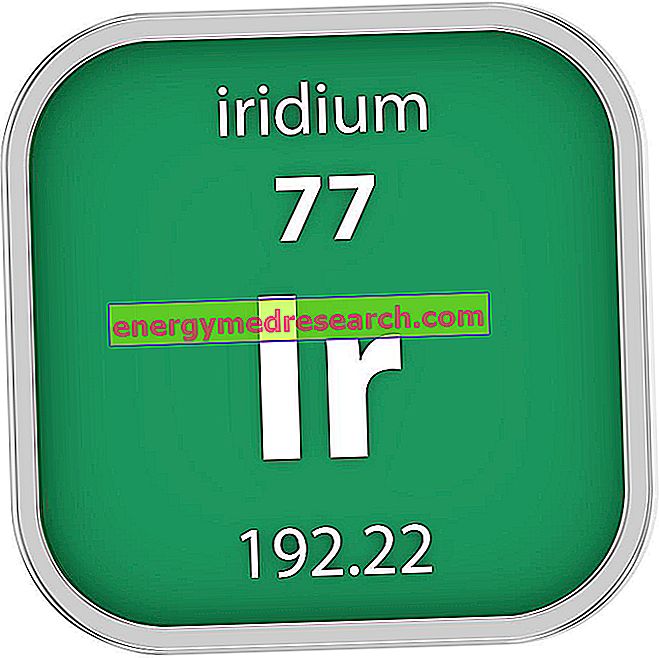Generality
The cerebral ventricles are the 4 communicating cavities of the brain, which provide for the production of the liquor and its sorting in the central nervous system.

Fundamental elements of the ventricular system, the cerebral ventricles are called singularly: right lateral ventricle, left lateral ventricle (these first cerebral ventricles are symmetrical), third ventricle and fourth ventricle.
Review to understand: Brain and Brain proper
The brain is, along with the spinal cord, one of the two fundamental components of the central nervous system .
Heavy about 1.4 kilograms and containing 100 trillion neurons (in the adult human being), the encephalon is a very complex structure that can be subdivided into 4 large regions, which are: the brain proper (or telencephalus or, simply, brain ), the cerebellum, the diencephalon and the brainstem .

BRAIN PROPERLY SAID
The brain is the largest and most important region of the brain.
Confining itself to the more general aspects of its anatomy, it consists of:
- Two large specular hemispheres (the so-called right cerebral hemisphere and left cerebral hemisphere ), separated by a groove (the interhemispheric sulcus ), and
- The so-called corpus callosum, located at the base of the two aforementioned cerebral hemispheres.
What are cerebral ventricles?
The cerebral ventricles are the 4 particular communicating cavities of the brain used for the production of the cerebrospinal fluid and for its transport inside the brain and the spinal cord (therefore in the central nervous system).
Cerebral Ventricles and Ventricular System
The cerebral ventricles are the main actors of the so-called ventricular system, that is the set of brain structures deputed to the production, circulation and removal of the cerebrospinal fluid .
In addition to the cerebral ventricles, among the structures that make up the ventricular system, there are:
- The interconnection pathways between the various ventricles, which are essential for the transport of the cerebrospinal fluid;
- The central spinal canal (or central canal ), which serves to connect the cerebral ventricles to the spinal cord;
- The subarachnoid cisterns, which are the centers for sorting the cerebrospinal fluid towards the various parts of the brain;
- The choroid plexuses (or choroid plexuses ), which are the groups of ependymal cells responsible for the production of the cerebrospinal fluid.
Anatomy
The 4 cerebral ventricles are:
- The right and left lateral ventricles,
- The so-called third ventricle e
- The so-called fourth ventricle .
Right and Left Lateral Ventricles
The lateral ventricles are one for the cerebral hemisphere; clearly, the right lateral ventricle resides in the right cerebral hemisphere, while the left lateral ventricle takes place in the left cerebral hemisphere.

The lateral ventricles have a really singular anatomy: seen from the side, they look like a Y with the right "branch" slightly more developed than the left "branch" and extended so that the classic "stem" is oriented towards the nape, while the two branches above the forehead.
The lateral ventricles form relations with all the lobes of the brain; in fact, continuing to imagine them similar to Y lying with the "stem" towards the nape:
- Their central part borders on the parietal lobe;
- Their branch in the upper position moves towards the frontal lobe;
- Their lower limb reaches the temporal lobe;
- Their stem pushes up to the occipital lobe.
The part of the brain ventricles that borders the parietal lobe is simply called the central part .
The part of the brain ventricles that reaches the frontal lobe is called the frontal horn .
The part of the cerebral ventricles that is projected towards the temporal lobe is called temporal horn .
Finally, the part of the cerebral ventricles that pushes up to the occipital lobe is called the occipital horn .
The lateral ventricles communicate with the third ventricle, each through a channel known as Monro's intraventricular foramen .
Third Ventricle
Belonging to the diencephalic area of the brain, the third ventricle is between the two lateral ventricles, in a lower position than the so-called central part, but higher than the temporal horn.
Having the hypothalamus on the floor, the third ventricle takes place, like a napkin in a napkin holder, in the slit that divides the thalamus portion of the right cerebral hemisphere from the thalamus portion of the left cerebral hemisphere.
If viewed from the side (best viewpoint to appreciate its features), the third ventricle shows 4 protrusions, two anterior (ie from the front side) and two posterior (ie from the nape of the neck); starting to list them from above, the anterior protrusions are the so-called supra-optic recess (above the optic chiasm) and the so-called infundibular recess (above the stem of the pituitary gland), while the posterior protrusions are the so-called recess above the epiphysis) and the so-called pineal process (in the direction of the epiphysis stem).
Below the rear recesses, the third ventricle houses the initial tract of the conduit which serves to transport the cerebrospinal fluid to the fourth ventricle; this conduit is known as the aqueduct of Silvio or the cerebral aqueduct.
Fourth Ventricle
Lower and posterior than the third ventricle, the fourth ventricle extends between the brain stem, which resides in front of it, and the cerebellum, which resides behind it; to be precise, compared to the brainstem, it is located at the junction of the Varolio bridge and the medulla oblongata (NB: they are, respectively, the intermediate portion and the lower portion of the brainstem).
In dealing with the brainstem, the fourth ventricle takes place in a depression of this important encephalic structure, whose name is rhomboid fossa ; site of facial colliculus, limiting sulcus (or sulcus limitans) and obex, the rhomboid fossa represents the so-called fourth ventricle floor.
When dealing with the cerebellum, on the other hand, the fourth ventricle is found behind the superior medullary velum and inferior medullary velum ; if the rhomboid was the floor of the fourth ventricle, the superior medullary velum and the inferior medullary velum of the cerebellum constitute the ceiling.

In its lower portion, the fourth ventricle inserts into the so-called cerebral spinal canal, that is, the element of the ventricular system which serves to introduce the cerebrospinal fluid into the spinal cord .
Moreover, remaining always in the lower parts of the fourth ventricle, this presents two holes in lateral position, called Luschka holes, and a hole in posterior position (towards the cerebellum), called Magendie hole ; the purpose of these three openings is to drain the cerebrospinal fluid into the so-called subarachnoid cisterns, so that its sorting takes place in the space between the meninga pia mater and the meninge arachnoid ( subarachnoid space ).
The holes of Luschka communicate with the subarachnoid cisterns known as quadrigeminal cisterns, while the Magendie forum with the cistern known as the cerebellomidollar cistern .
Curiosity
Of the 4 brain ventricles, the fourth ventricle is the one placed lower down inside the brain.
Cerebral Ventricles and Choroid Plexuses
Each cerebral ventricle has its own choroid plexus, ie those groupings of ependymal cells that have the fundamental task of producing the cerebrospinal fluid.
To be precise,
- The cerebral ventricles house their own choroid plexus in the central part and in the temporal horn;
- The third ventricle gives hospitality to its own choroid plexus in the supero-posterior part;
- The fourth ventricle houses its own choroid plexus just below where its closeness to the cerebellum ends.
Did you know that ...
In addition to the cerebral ventricles, Monro's intraventricular foramina, that is the channels that connect the lateral ventricles to the third ventricle, also have their own choroid plexus.
Development: during embryogenesis, what gives rise to cerebral ventricles?
The cerebral ventricles are embryological derivatives of the neural canal, ie the internal fossa of the neural tube.
Function
As anticipated, the cerebral ventricles have the function of producing and directing the circulation of the cerebrospinal fluid inside the brain and spinal cord.
What are the functions of the cerebrospinal fluid?
Also known as CSF or cerebrospinal fluid, the cerebrospinal fluid has several important functions, which are:
- Protect the encephalon and spinal cord from the dangerous consequences of collisions with traumas against them.
The cerebrospinal fluid acts as a cushion that absorbs shocks to the central nervous system;
- Create an ideal chemical environment for the correct functioning of central nervous system cells.
For example, liquor maintains the concentration of extracellular potassium within those limits that are indispensable for synaptic transmission;
- Nourish the central nervous system .
The cerebrospinal fluid participates in the exchange of metabolites and nutrients between brain and blood;
- Adjust intracranial pressure (or intracranial pressure ).
Cerebrospinal fluid regulates its volume based on changes in blood flow and brain mass, so as to maintain both intracranial pressure constant;
- Accept the waste products of the central nervous system cells and facilitate their removal .
The liquor removes waste products pouring everything into the bloodstream.
What is the cerebrospinal fluid?
The cerebrospinal fluid derives from a particular process of ultrafiltration of the blood plasma, a process that impoverishes it of proteins and varies its electrolytic composition (eg: it differs due to the concentration of chloride ion).
In normal conditions (ie in a healthy subject), the cerebrospinal fluid is a transparent fluid, free of red blood cells, with few white blood cells, with a low concentration of plasma proteins and with a pH between 7.28 and 7.32 .
Circulation of Liquor in the Cerebral Ventricles and Ventricular System
After its production by the choroidal plexuses, the liquor circulates, thanks to the interventricular foramina of Monro and the aqueduct of Silvio, in the various cerebral ventricles, up to take the central spinal canal and the holes of Luschka and Magendie, which serve to conduct it, respectively, in the subarachnoid space of the brain and in the subarachnoid space of the spinal cord.
In the subarachnoid space, therefore, whenever there is need for its renewal, it pours into the venous bloodstream, for its definitive elimination.
diseases
The cerebral ventricles can be the protagonists of a medical condition that is certainly known to most people: hydrocephalus .
In hydrocephalus, there is an abnormal accumulation of cerebrospinal fluid in the cerebral ventricles and in the subarachnoid space, followed by a suffering for the brain, sometimes with a fatal outcome.
Did you know that ...
There are two main types of hydrocephalus:
- The communicating hydrocephalus, in which the accumulation of liquor is due to an obstruction of the ventricular system located outside the cerebral ventricles (in these, the circulation of the liquor is therefore correct.
- The non-communicating hydrocephalus, in which the accumulation of cerebrospinal fluid is due to an occlusion of the ventricular system located in one of the cerebral ventricles.



